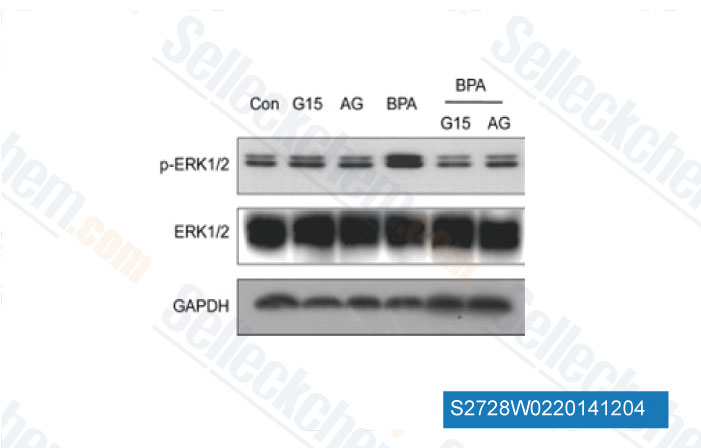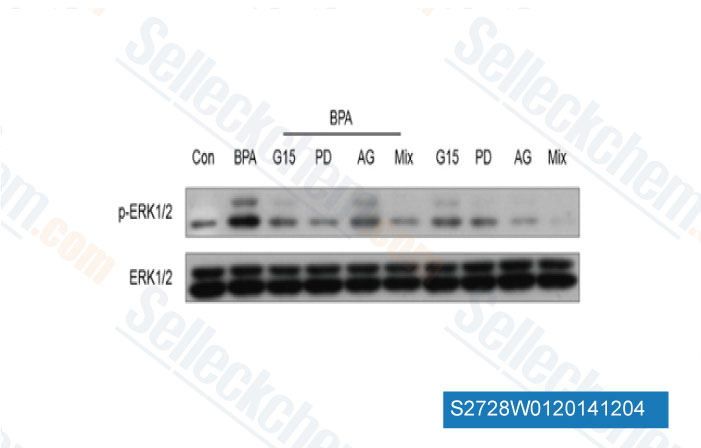|
Toll Free: (877) 796-6397 -- USA and Canada only -- |
Fax: +1-832-582-8590 Orders: +1-832-582-8158 |
Tech Support: +1-832-582-8158 Ext:3 Please provide your Order Number in the email. |
Technical Data
| Formula | C16H14ClN3O2 |
||||||||||||||
| Molecular Weight | 315.75 | CAS No. | 153436-53-4,175178-82-2 | ||||||||||||
| Solubility (25°C)* | In vitro | DMSO | 25 mg/mL (79.17 mM) | ||||||||||||
| Ethanol | 13 mg/mL (41.17 mM) | ||||||||||||||
| Water | Insoluble | ||||||||||||||
| In vivo (Add solvents to the product individually and in order) |
|
||||||||||||||
|
* <1 mg/ml means slightly soluble or insoluble. * Please note that Selleck tests the solubility of all compounds in-house, and the actual solubility may differ slightly from published values. This is normal and is due to slight batch-to-batch variations. * Room temperature shipping (Stability testing shows this product can be shipped without any cooling measures.) |
|||||||||||||||
Preparing Stock Solutions
Biological Activity
| Description | AG-1478 is a selective EGFR inhibitor with IC50 of 3 nM in cell-free assays, almost no activity on HER2-Neu, PDGFR, Trk, Bcr-Abl and InsR. This compound inhibits encephalomyocarditis virus (EMCV) and hepatitis c virus (HCV) by targeting phosphatidylinositol 4-kinase IIIα (PI4KA). | ||
|---|---|---|---|
| Targets |
|
||
| In vitro | AG-1478 is high selective over ErbB2 and PDGFR with IC50 of >100 μM. [1] This compound preferentially inhibits U87MG cells expressing truncated EGFR with IC50 of 8.7 μM, compared to those expressing endogenous wt EGFR or overexpressing exogenous wt EGFR with IC50 of 34.6 μM and 48.4 μM, respectively, and inhibits the DNA synthesis with IC50 of 4.6 μM, 19.67 μM, and 35.2 μM, respectively. This chemical also preferentially inhibits the tyrosine kinase activity and autophosphorylation of the ΔEGFR compared to endogenous or overexpressed exogenous wt EGFR. [2] It (0.25 μM) abolishes the MAPK activation induced by Ang II, a Ca2+ ionophore as well as EGF but not by a phorbol ester or platelet-derived growth factor-BB in the VSMC. [3] This compound inhibits EGF-induced mitogenesis of the BaF/ERX and LIM1215 cells with IC50 of 0.07 μM and 0.2 μM, respectively. [6] It is able to inhibit the function of ATP-binding cassette (ABC) transporters such as ABCB1 and ABCG2, with a more pronounced effect on ABCG2. [7] |
||
| In vivo | Administration of AG-1478 blocks phosphorylation of the EGFR at the tumor site and inhibits the growth of A431 xenografts that overexpress the WT EGFR and glioma xenografts expressing the de2-7 EGFR. Even subtherapeutic doses of this compound significantly enhance the efficacy of cytotoxic drugs, with the combination of this chemical displaying synergistic antitumor activity against human glioma xenografts. The combination of this compound and an anti-EGFR antibody (mAb 806) displays additive and in some cases synergistic, antitumor activity against tumor xenografts overexpressing the EGFR. [4] The combination of this compound (0.4 mg) with a single dose of 25 μCi 90Y-CHX-A''-DTPA-hu3S193 results in a significant enhancement of efficacy compared with either agent alone. [5] |
Protocol (from reference)
| Cell Assay: |
|
|---|---|
| Animal Study: |
|
References
|
Customer Product Validation

-
Data from [ Biomed Pharmacother , 2014 , 10.1016/j.biopha.2014.09.003 ]

-
Data from [ Toxicol Lett , 2014 , 226(1), 81-9 ]

-
Data from [ , , PLoS One, 2013, 8(8): e70353 ]
Selleck's AG-1478 Has Been Cited by 101 Publications
| p66Shc deletion confers apoptotic resistance to loss of EGFR-ERK signalling in neural stem cells [ Cell Death Dis, 2025, 16(1):479] | PubMed: 40593476 |
| Activation of GPER1 alleviates white matter injury by promoting microglia M2 polarization through EGFR/Stat3 pathway in intracerebral hemorrhage mice [ J Stroke Cerebrovasc Dis, 2025, 34(6):108315] | PubMed: 40228567 |
| Polypharmacological profiling across protein target families and cellular pathways using the multiplexed cell-based assay platform safetyProfiler reveals efficacy, potency and side effects of drugs [ Biomed Pharmacother, 2024, 180:117523] | PubMed: 39405910 |
| Calpain-2 mediates SARS-CoV-2 entry via regulating ACE2 levels [ mBio, 2024, e0228723.] | PubMed: 38349185 |
| AREG Upregulation in Cancer Cells via Direct Interaction with Cancer-Associated Fibroblasts Promotes Esophageal Squamous Cell Carcinoma Progression Through EGFR-Erk/p38 MAPK Signaling [ Cells, 2024, 13(20)1733] | PubMed: 39451251 |
| Profiling of ERBB receptors and downstream pathways reveals selectivity and hidden properties of ERBB4 antagonists [ iScience, 2024, 27(2):108839] | PubMed: 38303712 |
| Transforming Growth Factor α Evokes Aromatase Expression in Gastric Parietal Cells during Rat Postnatal Development [ Int J Mol Sci, 2024, 25(4)2119] | PubMed: 38396796 |
| The Electric Field Guided HaCaT Cell Migration Through the EGFR/p38 MAPK/Akt Pathway [ Curr Issues Mol Biol, 2024, 47(1)16] | PubMed: 39852131 |
| Crosstalk between cancer cells and macrophages promotes OSCC cell migration and invasion through a CXCL1/EGF positive feedback loop [ Discov Oncol, 2024, 15(1):145] | PubMed: 38713320 |
| Protocol for identifying properties of ERBB receptor antagonists using the barcoded ERBBprofiler assay [ STAR Protoc, 2024, 5(2):102987] | PubMed: 38635397 |
RETURN POLICY
Selleck Chemical’s Unconditional Return Policy ensures a smooth online shopping experience for our customers. If you are in any way unsatisfied with your purchase, you may return any item(s) within 7 days of receiving it. In the event of product quality issues, either protocol related or product related problems, you may return any item(s) within 365 days from the original purchase date. Please follow the instructions below when returning products.
SHIPPING AND STORAGE
Selleck products are transported at room temperature. If you receive the product at room temperature, please rest assured, the Selleck Quality Inspection Department has conducted experiments to verify that the normal temperature placement of one month will not affect the biological activity of powder products. After collecting, please store the product according to the requirements described in the datasheet. Most Selleck products are stable under the recommended conditions.
NOT FOR HUMAN, VETERINARY DIAGNOSTIC OR THERAPEUTIC USE.
